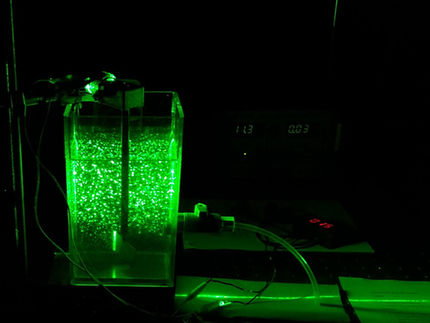Nature's chemical diversity reflected in Swedish lakes
It's not only the biology of lakes that varies with the climate and other environmental factors, it's also their chemistry. More knowledge about this is needed to understand the ecology of lakes and their role in the carbon cycle and the climate. Today an international research group led by Uppsala University is publishing a comprehensive study of the composition of organic compounds in the prestigious journal Nature Communications.
"Lake water is like a very thin broth with several thousand ingredients in the recipe, all with different properties. At the same time many of the molecules are common in a broad spectrum of different environments. For instance, in the extremely complex chemical mixture we have found the same components as colleagues have described from the Congo. And they react to environmental factors in the same way in the tropics as in Sweden", says Lars Tranvik, who directed the study.
All of the world's lakes cover only three per cent of the surface area of the continents, but they nevertheless play a huge role in the carbon cycle of the planet. Among other things, there is an outflow of carbon dioxide to the atmosphere. This is largely due to the fact that these lakes take in tremendous amounts of organic materials from the surrounding land, and these are also converted in the water with the help of microorganisms.
Most of this organic matter is found in dissolved form in the water and consists of thousands of different molecules. The present study is the most comprehensive investigation ever of how the composition of these organic compounds is formed by processes in lakes and their catchments in the surrounding landscape. The researchers have analysed the make-up of the dissolved organic matter in 120 lakes from north to south in Sweden, as well as how its composition varies with the climate and other factors.
The study is a collaborative project involving a group of scientists from the Limnology program at Uppsala University and the Max Planck Institute for Marine Microbiology in Bremen/ University of Oldenburg. It is based on, among other things, data from a national environmental survey which monitors water chemistry and other properties of lakes. In addition, the researchers have performed detailed analyses of the organic material with the help of a powerful instrument in Germany – a high-resolution mass spectrometer.
The results show that not only biological diversity but also chemical diversity is regulated by various environmental factors. For example, in lakes with long water retention times, that is, where the water remains in place for a long period before being transported downstream, molecules from surrounding forests and wetlands are largely broken down.
"This leads to a completely different chemical composition, where the content of compounds that are produced by plankton in the lakes is more dominant", says Anne Kellerman, a doctoral candidate who is the lead author of the article.
By comparing lakes in different climates, we can get a picture of what chemical composition the water will have in a future climate with higher temperatures and more precipitation. This has consequences for how we should locate and design plants for drinking water production in the future.
"We're now continuing our investigations of the chemical diversity of nature by trying to figure out what mechanisms underlie the patterns we're finding. What determines that organic material in some cases is preserved in nature for a long time, and why is it degraded quickly under different circumstances?", wonders Lars Tranvik.
This research is being conducted in a strong research environment funded by the Swedish Research Council Formas, "Color of Water", which is analysing current and future changes in the organic matter in lakes, and how this affects both drinking-water production and the ecology of the lakes.
Organizations
Other news from the department science

Get the chemical industry in your inbox
By submitting this form you agree that LUMITOS AG will send you the newsletter(s) selected above by email. Your data will not be passed on to third parties. Your data will be stored and processed in accordance with our data protection regulations. LUMITOS may contact you by email for the purpose of advertising or market and opinion surveys. You can revoke your consent at any time without giving reasons to LUMITOS AG, Ernst-Augustin-Str. 2, 12489 Berlin, Germany or by e-mail at revoke@lumitos.com with effect for the future. In addition, each email contains a link to unsubscribe from the corresponding newsletter.





























































